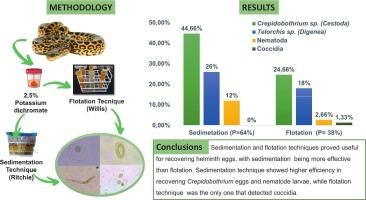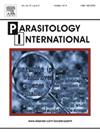用共寄生虫学方法研究野生黄水蟒体内的寄生虫。
IF 1.9
4区 医学
Q3 PARASITOLOGY
引用次数: 0
摘要
蛇是爬行动物中最大的一类,在食物链中起着至关重要的作用,有助于生态系统的平衡。尽管如此,它们仍然是野外研究最少的爬行动物。摘要本研究以阿根廷La Estrella沼泽黄水蟒(Eunectes notaeus)为研究对象,利用浮选、沉淀及染色等方法,对其粪便进行分析。2019年至2023年期间,从Fortín La Soledad的“黄色蟒蛇管理计划”中收集了150份粪便样本。样品采用定性改良Ritchie沉淀法(ST)、Willis浮选法(FT)和Kinyoun染色法进行处理。恢复了4个分类群的寄生形态。寄生的患病率(P)是64年 % (ST)和38 %(英尺),发现了下面的分类单元:Crepidobothrium sp。(绦虫类)鸡蛋(P = % ST和24.66 % 44.66英尺),Telorchis sp。(复殖类)鸡蛋(P = 26 % ST和18 %英尺),和线虫纲幼虫和卵(P = 12 % ST和2.66 %英尺)。FT检测球虫(P = 1.33 %)。Ritchie法比Willis法更有效,特别是在回收Crepidobothrium卵和线虫幼虫方面,而Willis法是唯一检测球虫的方法。未发现隐孢子虫卵囊。在这项研究中,寄生形式的诊断代表了对蛇寄生虫学的宝贵贡献,以及对所使用技术的有效性的评估。本文章由计算机程序翻译,如有差异,请以英文原文为准。

Endoparasites in yellow anaconda (Eunectes notaeus) in the wild through coproparasitological tools
Snakes constitute the largest group of reptiles and play a crucial role in food chains, contributing to the balance of ecosystems. Despite this, they remain the least studied reptiles in the wild. This study aimed to identify the parasitic forms present in a wild population of yellow anacondas (Eunectes notaeus) from La Estrella marsh, Formosa, Argentina, through faecal matter analysis using flotation, sedimentation, and staining techniques. Between 2019 and 2023, 150 faecal samples were collected from the “Yellow Anaconda Management Program” in Fortín La Soledad. The samples were processed using the qualitative modified Ritchie sedimentation technique (ST), Willis flotation technique (FT), and Kinyoun staining. Parasitic forms belonging to four taxa were recovered. The prevalence of parasitism (P) was 64 % (ST) and 38 % (FT), and the following taxa were detected: Crepidobothrium sp. (Cestoda) eggs (P = 44.66 % ST and 24.66 % FT), Telorchis sp. (Digenea) eggs (P = 26 % ST and 18 % FT), and Nematoda larvae and eggs (P = 12 % ST and 2.66 % FT). Also, coccidia were detected using the FT (P = 1.33 %). The Ritchie method was more effective than the Willis method, specifically in recovering Crepidobothrium eggs and nematode larvae, while the Willis method was the only one that detected coccidia. No Cryptosporidium oocysts were found. In this study, the diagnosis of parasitic forms represents a valuable contribution to the ophidian parasitology, as well as an evaluation of the effectiveness of the techniques used.
求助全文
通过发布文献求助,成功后即可免费获取论文全文。
去求助
来源期刊

Parasitology International
医学-寄生虫学
CiteScore
4.00
自引率
10.50%
发文量
140
审稿时长
61 days
期刊介绍:
Parasitology International provides a medium for rapid, carefully reviewed publications in the field of human and animal parasitology. Original papers, rapid communications, and original case reports from all geographical areas and covering all parasitological disciplines, including structure, immunology, cell biology, biochemistry, molecular biology, and systematics, may be submitted. Reviews on recent developments are invited regularly, but suggestions in this respect are welcome. Letters to the Editor commenting on any aspect of the Journal are also welcome.
 求助内容:
求助内容: 应助结果提醒方式:
应助结果提醒方式:


